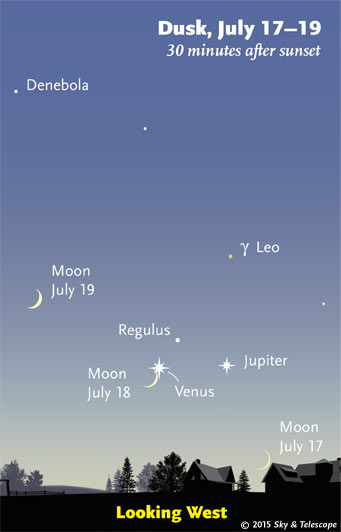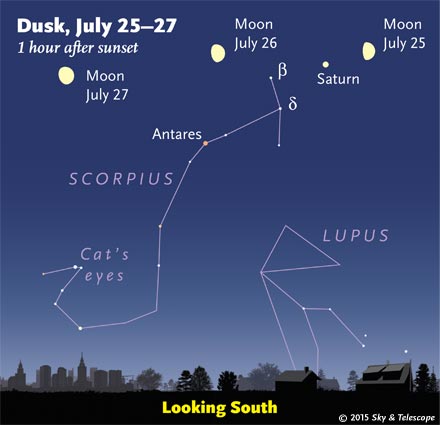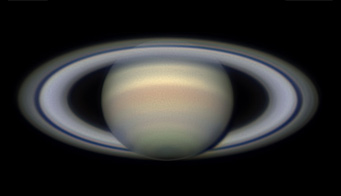Friday, July 17
The two brightest stars of summer, Arcturus and Vega, shine equally close to the zenith as the stars come out this week. Vega is the brightest star very high in the east. Arcturus is the brightest very high in the southwest.

Saturday, July 18
Look west soon after sunset to spot Venus and the thin crescent Moon just a couple degrees apart (as seen from North America). As the sky darkens, Regulus will appear above them. Jupiter has moved away to shine 6° to Venus's right.
Sunday, July 19
The Big Dipper hangs in the northwest after dark. Follow the curve of its handle around by a little more than a Dipper-length and there's bright Arcturus, due west. It's the nearest orange-giant star, 37 light-years away. Arcturus is actually a very pale yellow-orange: ginger-ale color.
Monday, July 20
After nightfall, Altair shines high in the southeast. It's the second-brightest star on the eastern side of the sky, after Vega high to its upper left. Above Altair by a finger-width at arm's length is little orange Tarazed. And a bit more than a fist-width to Altair's lower left, look for Delphinus the Dolphin leaping leftward.
Tuesday, July 21
Arcturus shines very high above the crescent Moon at nightfall. Arcturus is the brightest star of Bootes, the Herdsman. The main stars of Bootes form a narrow, slightly bent kite that currently extends up from Arcturus (where the tail would be tied on). The kite is about two fists at arm's length tall.
Wednesday, July 22
Look southwest this evening for Spica shining about 7° left of the Moon (for North America).
Thursday, July 23
First-quarter Moon (exact at 12:04 a.m. Friday morning EDT; 9:04 p.m. Thursday evening PDT). Spica now shines about 7° to the Moon's lower right (for North America).
Friday, July 24
The Moon this evening appears more than halfway from Spica (far to its lower right) to Saturn (left of the Moon). Much closer to the Moon, look for fainter Alpha Librae (Zubenelgenubi), a very wide double star for binoculars.
Saturday, July 25
Ceres, the first-discovered asteroid, is at opposition. It's glimmering south of Capricornus within binocular reach at magnitude 7.5. Use the finder chart in the July Sky & Telescope, page 50.
The waxing gibbous Moon poses to the right of Saturn this evening, as shown below.

__________________________
Want to become a better astronomer? Learn your way around the constellations. They're the key to locating everything fainter and deeper to hunt with binoculars or a telescope.
This is an outdoor nature hobby. For an easy-to-use constellation guide covering the whole evening sky, use the big monthly map in the center of each issue of Sky & Telescope, the essential guide to astronomy.

Once you get a telescope, to put it to good use you'll need a detailed, large-scale sky atlas (set of charts). The standards are the little Pocket Sky Atlas, which shows stars to magnitude 7.6; the larger and deeper Sky Atlas 2000.0 (stars to magnitude 8.5); and once you know your way around, the even larger Uranometria 2000.0 (stars to magnitude 9.75). And read how to use sky charts with a telescope.
You'll also want a good deep-sky guidebook, such as Sue French's Deep-Sky Wonders collection (which includes its own charts), Sky Atlas 2000.0 Companion by Strong and Sinnott, the bigger Night Sky Observer's Guide by Kepple and Sanner, or the beloved if dated Burnham's Celestial Handbook.
Can a computerized telescope replace charts? Not for beginners, I don't think, and not on mounts and tripods that are less than top-quality mechanically (meaning heavy and expensive). As Terence Dickinson and Alan Dyer say in their Backyard Astronomer's Guide, "A full appreciation of the universe cannot come without developing the skills to find things in the sky and understanding how the sky works. This knowledge comes only by spending time under the stars with star maps in hand."
This Week's Planet Roundup

Mercury and Mars are down deep in the glare of sunrise.
Venus and Jupiter remain two bright "stars" low in the west in twilight. They shine at magnitudes –4.7 and –1.8, respectively; Jupiter is the one on the right. They're 6° apart this week. Look for fainter Regulus above them. They all move a little lower every day.
Saturn (magnitude +0.3, in Libra upper right of the head of Scorpius) is highest in the south in twilight. It moves lower in the southwest after dark. Lower left of Saturn by 13° twinkles fiery orange Antares, not quite as bright. Delta Scorpii is the star roughly midway between them.
Uranus (magnitude +5.8, in Pisces) and Neptune (magnitude +7.8, in Aquarius) are in the southeast and south, respectively, before the beginning of dawn; finder charts.
__________________________
All descriptions that relate to your horizon — including the words up, down, right, and left — are written for the world's mid-northern latitudes. Descriptions that also depend on longitude (mainly Moon positions) are for North America.
Eastern Daylight Time (EDT) is Universal Time (UT, UTC, or GMT) minus 4 hours.
__________________________
“This adventure is made possible by generations of searchers strictly adhering to a simple set of rules. Test ideas by experiments and observations. Build on those ideas that pass the test. Reject the ones that fail. Follow the evidence wherever it leads, and question everything. Accept these terms, and the cosmos is yours.”
— Neil deGrasse Tyson, 2014
 3
3
Comments
July 20, 2015 at 7:13 am
I can't seem to find a version for the Southern Hemisphere - can you help?
Thanks and regards
You must be logged in to post a comment.
mary beth
July 23, 2015 at 12:44 am
I found these websites but it appears most content is in the printed version of the magazine.
http://www.austskyandtel.com.au/Home/tabid/586/Default.aspx
http://skyandtelescope.org/wp-content/uploads/GettingStartedSouth.pdf
Hope it helps!
You must be logged in to post a comment.
July 31, 2015 at 12:38 am
Hi Mary -
Thanks for the links, but as you say there is a shortage of online info..
I'm sure they used to do a 'southern skies' option at one time?
Thanks for your help!
You must be logged in to post a comment.
You must be logged in to post a comment.